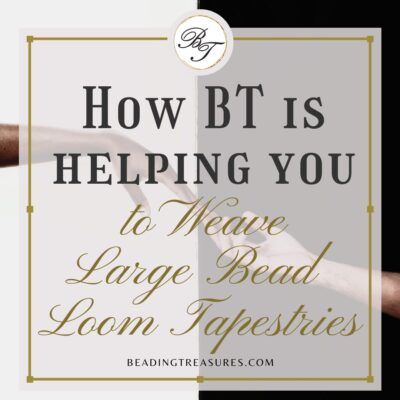Design
Create or Purchase Patterns for Bead Loom Tapestries
Follow us on
Following your inspiration…. you’ve determined what kind of image you want to weave.
At this stage, you might need to do a bit more research online to find a ready-made pattern.
Alternatively, you could make your own from the photo or image that inspired you. Or if you cannot find anything and do not want to do the hardest part of tapestry bead weaving yourself, let me do it for you! Commission a tapestry pattern.
So should you create or purchase patterns?
This particular article will talk about ready-made patterns and how to find them, and a list of programs that will help design your large-scale bead tapestries.
How on earth do I get that pattern?
For ideas for what to do with a photo or image that you have selected, I will cover that in a separate blog.
I will be covering how to use Beadtool4, BeadCreator, and other popular programs used today that help you to design your tapestries or convert images into designs… with much more detail… in other posts.
Signup if you haven’t already to stay in the loop.
In the meantime, though you can…
Look for patterns available online
In my experience, Pinterest, ETSY, and Artfire are where you will find patterns online mostly.
You could also join some groups on Facebook, some of which share patterns.
You will find though that most of the patterns offered are in the Peyote bead weaving stitch.
Pinterest has some patterns that are free so it is worth looking around.
You might find it hard to find large loom patterns though as most of them are for the Peyote weaving stitch. There are lots of patterns for small pieces such as bracelets etc.
ETSY and Artfire are online stores where you can buy all sorts of patterns.
Before purchasing a pattern though, look to see if there are completed patterns by the artist. Preferably the pattern you are wanting but not necessarily. You are looking to determine the skill of the designer.
Ordinarily, it is great to have a completed tapestry to see before you purchase the pattern, but for large tapestries, this is often not feasible for the designer to weave all of his or her patterns.
The amount of time it takes to design and then weave the tapestry makes this very difficult. Good designers have learned their lessons the hard way believe me. Mistakes in colors and design are much more difficult to fix and adjust in larger tapestries.
So if you like a woven tapestry a particular designer has done and you can see the skill of the designer shining through, go ahead and purchase that pattern.
What to look for before purchasing a pattern
- The interpretation of the colors and finishes of the beads in completed tapestries
- The clarity and beauty of any completed tapestries
- Reviews and comments by customers
- What is in the patterns, for example, grid or word chart, etc?
- The type of beads used, for example, Delica
- The number of bead colors needed for the pattern
I should mention though, you will need to purchase any patterns listed on Etsy and Artfire as they are online stores.
Patterns available on Beading Treasures
I offer patterns on the Beading Treasures SHOP specifically designed for large tapestries. If you have a look there, you might find some smaller-scale ones too.
These smaller ones are sometimes offered as Hidden Gems in THE VAULT. They are there to help in bridging the gap from beading, say an 80-bead wide piece to a 100-bead wide piece.
The size of the patterns I offer range from:
- Tiny: 100 Beads Wide (Per Row), 13.56 cm or 5.33 Inches wide.
- X Small: 150 Beads Wide (Per Row), 20.34 cm or 8 inches wide.
- Small: 200 Beads Wide (Per Row), 27.12 cm or 10.67 Inches wide.
- Medium: 250 Beads Wide (Per Row), 33.9 cm or 13.34 inches wide.
- Large: 300 Beads Wide (Per Row), 40.68 cm or 16.01 inches.
- X Large: 350 Beads Wide (Per Row), 47.46 cm or 18.68 inches.
- Huge: 400 Beads Wide (Per Row), 54.24 cm or 21.35 inches.
- Gigantic: 450 Beads Wide (Per Row), 60.75 cm or 23.92 inches.
Now I know for us large tapestry bead loom weavers the 100 beads wide tapestry is not Tiny, but to non-weavers, it does seem like it.
Perhaps because the amount of work, effort, and patience is not known to them.
Bead weaving patterns and other goodies are offered to subscribers periodically in our newsletters. Sign up for the newsletter so you don’t miss out. You might also find some Hidden Gems in THE VAULT that you like for which the key will be visible when you have logged in.
Cross Stitch Patterns
Cross-stitch patterns can definitely be used. A word of caution though, cross-stitch patterns do not take into account the size of the beads.
Why is that an issue?
Well in cross-stitch work, the crosses (the equivalent of a bead) have the same height and width. So in effect, each cross is a perfect square. Beads are not. They tend to have a larger height-to-width ratio.
Here I am using a size 11/0 Delica bead to as an example because Delica beads are the most common beads used by bead tapestry weavers.
The reasons for which bead tapestry loom weavers use Delica are:
- The quality of the beads requires very little culling compared to other brands (Culling is another word for sorting. It ensures that only uniform beads are used).
- The color range and finishes are available.
- Value for money, less culling means more beads used.
- Delica beads are readily available in bead shops and online
- The code reference of the bead color itself insures that you purchase exactly the color you need for your pattern.
You can head over to the MIYUKI website for more information, Miyuki is the company that makes the Delica beads… among others.
Read this post for more info on Delica beads and the comparison between Delica and seed beads.
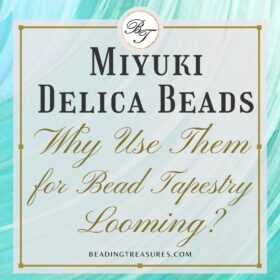
The Miyuki company lists the size of an 11/0 Delica bead to be 1.35 cm in width and 1.75 cm in height. That is an extra 0.4 cm in height compared to width. These 0.4 cm accumulate row by row making the end piece longer than it should be.
This size issue applies to other brands of beads say… Preciosa for example. Some brands more than others. The best way is to weave a sample and check the measurements.
So when you follow a cross stitch pattern for bead tapestry work… the piece will end up a bit distorted. It will bit a bit longer as if someone had pulled on it from the top let us say.
Let me show you an example of beadwork that I have done using a cross-stitch pattern.
So be aware, when using cross stitch patterns your bead tapestry may turn out taller than you realize.
For more information about this particular beaded tapestry head to the Portfolio page.
Good bead tapestry designers take this into account and make modifications to accommodate this when designing beaded tapestries.
You will also need to convert the DMC thread colors to the colors of the beads you will be using.
You will find a DMC to Delica conversion chart as a Hidden Gem in THE VAULT. Be aware that this chart was compiled in 2009.
This means that any new Delica beads manufactured after that year, will not be included in the list. There seem to be enough colors though. Please check the colors for yourself as well.
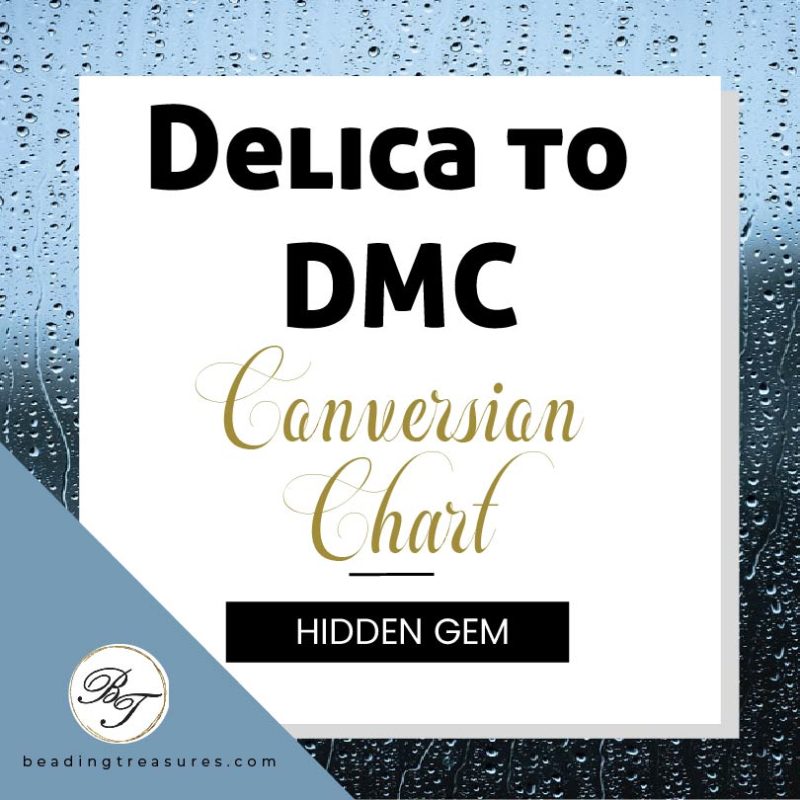
How do I read The DMC to Delica table?
Let’s say that my cross-stitch pattern calls for the DMC thread color number 211.

-Go through the table under the DMC column, and find that number.
-Look for the Delica equivalent right next to it.
-Note it down on your pattern.
In the case of DMC 211 in the table above, there are 2 different Delica Numbers. Write both combinations down. Use your judgment to select which one is the more appropriate to use.
There is also one last thing to consider when choosing a cross-stitch pattern.
Cross-stitch patterns use half stitches and single threads to define areas of the pattern. Have a look at the image below. Note the thin lines leading to the tiny red flowers and the green leaves and the text in the image below.
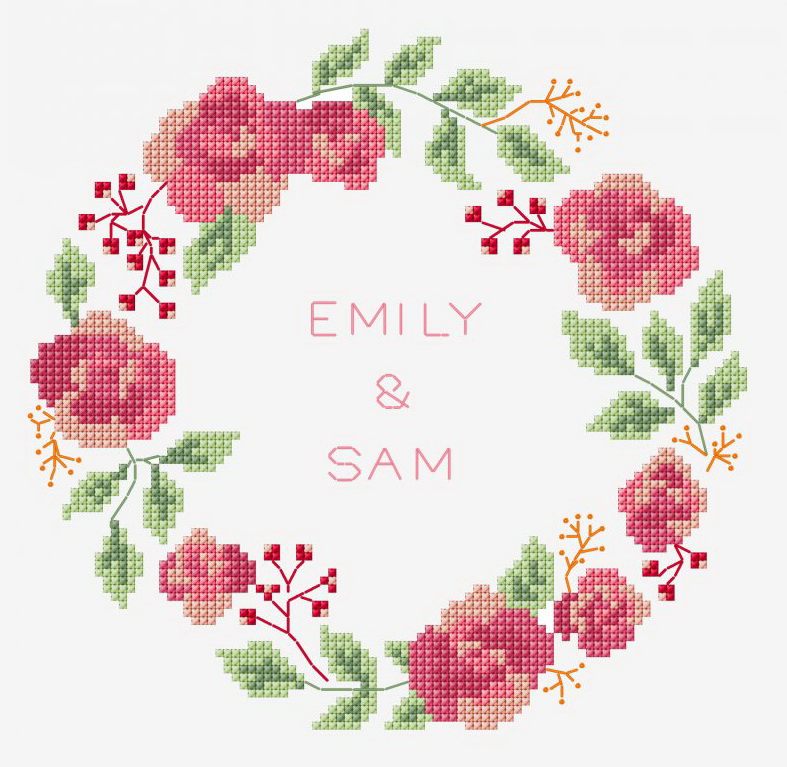
Design your own pattern
To read a brief list of tools that allow for the creation of your own pattern, head on over to this blog…
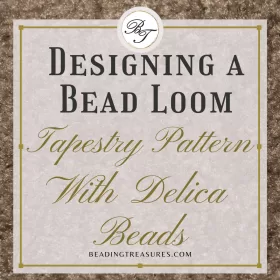
Where I talk about the most popular bead designing software available both online and as software, mentioning the functionality and cost.
In a nutshell
There are so many ways to get a pattern, searching online gives you a great idea of what is available and what type of tapestry images you like. Start there, and then either design your own or purchase ready-made or have one commissioned.
Choose design software that meets your needs but more importantly that you would enjoy using. Designing a pattern takes time and if you don’t enjoy the process you might throw in the towel.
Please don’t let the design stage stop you from weaving your tapestry.
It can be the most annoying for some and it does not have to be. Purchase or commission a pattern… and weave big!
If you have a favorite program, app, or online tool that you use to design large-scale tapestries, not mentioned above of course, please let me know!
Email me or write in the comments below.
I’ll check it out and write about it.
Let’s share and grow our bead tapestry weaving community.
Speaking of the bead tapestry community…where do most of us go on social media to connect?
Facebook, Instagram, Pinterest….?
Please let me know where your favorite place is in the comments below.
It would be great if we had a group on Facebook for specifically LARGE bead tapestry looming, wouldn’t it?
Latest posts
Beading Informative Technical
Best Thread Color to Use with your Patterns
What is the best thread and thread color to use for weaving your bead tapestry?
Dec
Beading Informative Technical
Best Way to Weigh Your Beads
How best to go about weighing the beads in your stash before purchasing more for[...]
Dec
Beading Design Informative
How BT is Helping You to Weave Large Bead Loom Tapestries
All things beading, bead looming large tapestries and digital planning for beaders.
Mar
Hi there ! I’m Nedal.
I created Beading Treasures to make information about beading large tapestries more accessible, and in doing so encouraging creating of this amazing art form.
Weaving BIG can seem intimidating but by using some techniques it is totally doable, no more than that it is really enjoyable!
If you’ve found this blog helpful, please support me by choosing the affiliate products on my blog and following me on my social platforms.
Don’t forget to check out the shop!
Thank you!
Nedal Douaihy, Artist & Founder

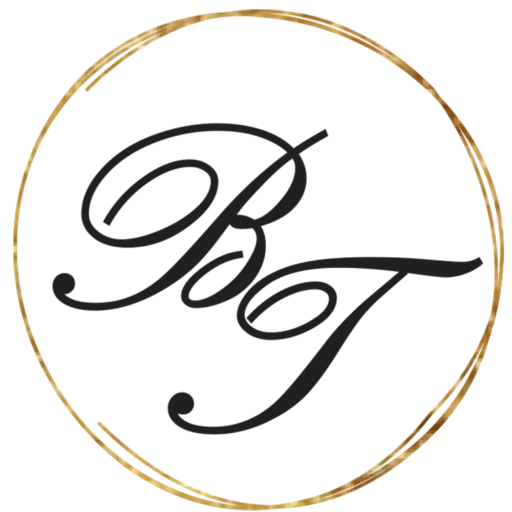

![BLOG COVER [Create or Purchase Patterns]](https://beadingtreasures.com/wp-content/uploads/2020/10/BLOG-COVER-Create-or-Purchase-Patterns-800x800.jpg)


